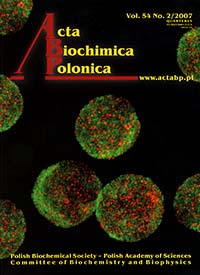Kinetic intermediates of unfolding of dimeric prostatic phosphatase.
Abstract
Kinetics of guanidine hydrochloride (GdnHCl)-induced unfolding of human prostatic acid phosphatase (hPAP), a homodimer of 50 kDa subunit molecular mass was investigated with enzyme activity measurements, capacity for binding an external hydrophobic probe, 1-anilinonaphtalene-8-sulfonate (ANS), accessibility of thiols to reaction with 5,5'-dithiobis(2-nitrobenzoic acid) (DTNB) and 2-(4'-maleimidylanilino)naphthalene-6-sulfonate (MIANS) and ability to bind Congo red dye. Kinetic analysis was performed to describe a possible mechanism of hPAP unfolding and dissociation that leads to generation of an inactive monomeric intermediate that resembles, in solution of 1.25 M GdnHCl pH 7.5, at 20 degrees C, in equilibrium, a molten globule state. The reaction of hPAP inactivation in 1.25 M GdnHCl followed first order kinetics with the reaction rate constant 0.0715 +/- 0.0024 min(-1) . The rate constants of similar range were found for the pseudo-first-order reactions of ANS and Congo red binding: 0.0366 +/- 0.0018 min(-1) and 0.0409 +/- 0.0052 min(-1), respectively. Free thiol groups, inaccessible in the native protein, were gradually becoming, with the progress of unfolding, exposed for the reactions with DTNB and MIANS, with the pseudo-first-order reaction rate constants 0.327 +/- 0.014 min(-1) and 0.216 +/- 0.010 min(-1), respectively. The data indicated that in the course of hPAP denaturation exposure of thiol groups to reagents took place faster than the enzyme inactivation and exposure of the protein hydrophobic surface. This suggested the existence of a catalytically active, partially unfolded, but probably dimeric kinetic intermediate in the process of hPAP unfolding. On the other hand, the protein inactivation was accompanied by exposure of a hydrophobic, ANS-binding surface, and with an increased capacity to bind Congo red. Together with previous studies these results suggest that the stability of the catalytically active conformation of the enzyme depends mainly on the dimeric structure of the native hPAP.Acta Biochimica Polonica is an OpenAccess quarterly and publishes four issues a year. All contents are distributed under the Creative Commons Attribution-ShareAlike 4.0 International (CC BY 4.0) license. Everybody may use the content following terms: Attribution — You must give appropriate credit, provide a link to the license, and indicate if changes were made. You may do so in any reasonable manner, but not in any way that suggests the licensor endorses you or your use.
Copyright for all published papers © stays with the authors.
Copyright for the journal: © Polish Biochemical Society.


